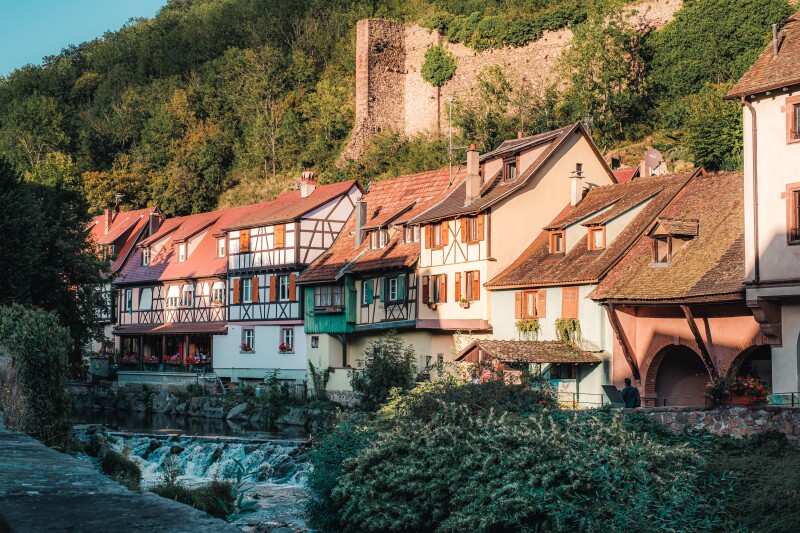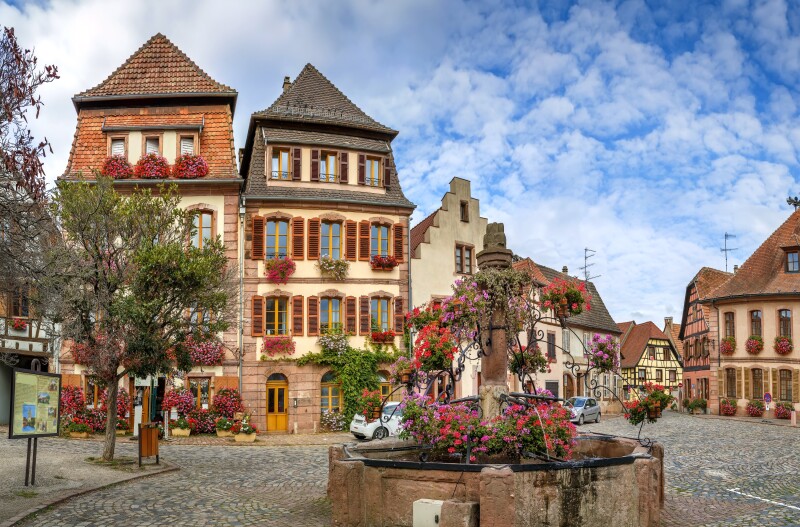The French love a good contest. From Paris’s annual baguette competition held each April to the cow “beauty pageant” at the Salon de l’Agriculture in late February, there’s no stopping the matchups. Even villages in the countryside of France are judged in Le village préféré des Français (“French people’s favorite village”), an annual TV show hosted by journalist Stéphane Bern (aka Monsieur Patrimoine).
The premise is simple and fun: there are 14 candidates, each representing a French region, and the French public vote for their favorite. In a country known for villages so pretty they look straight out of a film set, that’s no easy feat. The result for the lucky winner is an undeniable boon for tourism.
Here’s a look at 13 of the heart-stealing champs.
1. Saint-Cirq-Lapopie
- Location: Occitanie; 30 minutes from Cahors
- 2012 winner
From its vertiginous perch on a craggy cliff, this honey-colored hamlet is reflected in the waters of the Lot River below. A tangle of medieval alleyways tumbles down the hillside, dominated by the 16th-century Gothic church. Much of the village has remained unchanged since the Middle Ages, and today harbors 13 classified historic monuments, including the 14th-century stone house, Maison Bordes, and a hospital dating to the 13th. Saint-Cirq-Lapopie has attracted artists and writers since the early 20th century, including surrealist poet André Breton, who summered among the hollyhocks. That it’s just 30 minutes from Cahors puts the village in the middle of Lot, one of France’s lesser-known (i.e., less crowded) wine regions.

Eguisheim’s Place du Château, aka Saint-Leon square, is named for native son Pope Leo IX.
Courtesy of Tourisme Eguisheim-Rouffach
2. Eguisheim
- Location: Alsace; 15 minutes from Colmar
- 2013 winner
Traditional roots run as deep as the vineyards in this village straight out of a storybook, where half-timbered houses are festooned with geraniums. Eguisheim is situated on Alsace’s fabled Wine Route, which was launched in 1953. Local winemakers have been working the land for generations: Domaine Paul Schneider is an independent, family-owned winery housed in a 17th-century tithe barn, while Domaine Emile Beyer has transmitted its viticultural savoir faire since 1580 (that’s 14 generations).

Surprises await along the narrow cobblestone streets of Cordes-sur-Ciel in southeastern France.
Courtesy of Benjamin Dehant/Unsplash
3. Cordes-sur-Ciel
- Location: Occitanie; 75 minutes from Toulouse
- 2014 winner
Photogenic is an understatement here. Rising high above the sun-baked Occitan valleys, this 13th-century hilltop village noses the clouds—hence the phrase “sur ciel” (“in heaven”) added to the official name in 1993. From the fortified gate, steep cobblestone lanes wind uphill to a postcard panorama. Artists and writers gravitate here (Albert Camus was a fan), and you’ll find a number of artisans’ boutiques among the Gothic houses made of ochre sandstone.

The Ploumanac’h Lighthouse was rebuilt in 1946 after German troops destroyed it in 1944.
Photo by Teddy Verneuil/Lezbroz
4. Ploumanac’h
- Location: Brittany; two hours from Rennes
- 2015 winner
Generations of vacationers have heard the siren song of Brittany’s Pink Granite Coast. Swept by dramatic tides, the shore is strewn with spectacular boulders and rock formations among sandy beaches. In the heart of this idyllic setting sits the village port of Ploumanac’h. Landmarks include the lighthouse, historic tide-operated mill, and a myth-shrouded island oratory dedicated to Saint Guirec, said to be an evangelizing Welsh monk who arrived on this beach in the 6th or possibly 7th century. From here, boat excursions depart for the Sept-Îles, an archipelago that’s an important sanctuary for migrating birds, including puffins and northern gannets. Spring and summer are best for bird-watching.

Like many of the villages listed, Rochefort-en-Terre dates back to the Middle Ages.
Photo by Alexandre Lamoreux
5. Rochefort-en-Terre
- Location: Brittany; 80 minutes from Rennes
- 2016 winner
This village of 700 inhabitants, about 30 minutes’ drive from the coast, offers another side of Brittany. Rochefort-en-Terre dates to the 12th century, but a new tradition was born in the early 20th century, when American artist Alfred Klots fell under Rochefort’s spell and settled here, restoring a ruined castle as his home. In 1907, he launched an annual window box competition, and Rochefort blossomed into a city of geraniums, the granite facades of historic houses decorated in bright colors. A highlight on the cultural calendar is the annual Christmas illuminations, which draw visitors from all over France.

Kaysersberg translates to “Emperor’s Mountain” in German.
Photo by Lez Broz - Visit Alsace
6. Kaysersberg
- Location: Alsace, 1 hour from Strasbourg
- 2017 winner
Stork nests, vine-clad hillsides, colorful half-timbered houses next to the River Weiss: It’s the quintessential portrait of Alsace in Kaysersberg, also situated on the Wine Route. Lorded over by the ruins of a strategically built 13th-century castle, Kaysersberg is home to the destination hotel-restaurant Le Chambard, where beloved TV host Anthony Bourdain died. Here, chef Olivier Nasti operates a Michelin two-starred establishment alongside a casual winstub, or traditional brasserie.
7. Cassel
- Location: Hauts-de-France; 45 minutes from Lille
- 2018 winner
This fortified hilltop village, with its origins going back to the Iron Age, has borne the brunt of a millennium-old geopolitical tug of war. At the crossroads of Roman roads in ancient Gaul, Cassel was sacked by the Vikings in the late 9th century, and later became a 17th-century war prize fought over by France and Spain. Today, Cassel offers an immersion in Flemish culture just eight miles from the Belgian border. Brick gabled houses line the Grand’Place, estaminets dish up traditional cuisine like carbonnade flamande (a beef stew made with beer), and Carnival brings wondrous street parades of “giants” made of papier-mâché, wood, and fabric.

The UNESCO-listed Fortifications of Vauban date to the early 17th century.
Courtesy of Jeroen Roegist/Unsplash
8. Saint-Vaast-la-Hougue
- Location: Normandy; 30 minutes from Cherbourg
- 2019 winner
Often likened to Ireland, the wild Cotentin Peninsula is marked by wind-swept moors tumbling over rocky cliffs into the English Channel. This coastal fishing village welcomes sailors to its yacht marina, one of the largest in Normandy. The village of under 2,000 people is also known for its oyster production and 17th-century towers that are part of the UNESCO-listed fortifications of Vauban, Louis XIV’s military engineer. You can reach Tatihou Island just offshore on foot during low tide across the oyster beds.

The eastern French village of Hunspach has both French and German influence.
Photo by PierreleXplorateur - ADT
9. Hunspach
- Location: Alsace; 45 minutes from Strasbourg
- 2020 winner
The fairy-tale region of Alsace clinched a third “favorite village” title when Hunspach won. Close to both the German border and the thickly forested Northern Vosges Regional Nature Park, Hunspach combines charm with easy access to hiking trails. Its central area has been classified as a historic monument by the French government. For a break from strolling the cobblestone streets of this quaint village, stop into Kelsch’ Idée, a boutique selling kelsch, the traditional fabric made of linen and cotton.

Getting a panoramic view of Sancerre, in the Loire Valley, is one of the best ways to appreciate its landscape.
Photo by barmalini/Shutterstock
10. Sancerre
- Location: Centre-Val de Loire; 90 minutes from Orléans
- 2021 winner
For many, Sancerre is synonymous with the crisp white wine from the Loire Valley. Perched on a rocky outcrop overlooking the Loire River, the medieval town that gave the wine its name overlooks vineyards as far as the eye can see. (The view from the top of the Tour des Fiefs is magnificent.) Don’t miss the 15th-century Maison Jacques Cœur, the village’s oldest house, which once belonged to King Charles VII’s royal advisor.

Bergheim is known for the medieval fortified walls that surround it.
Photo by Borisb17/Shutterstock
11. Bergheim
- Location: Alsace; 40 minutes from Strasbourg
- 2022 winner
The flower-filled window boxes and pastel-hued houses may evoke a charming fantasy, but the history of Bergheim is anything but. Between 1582 and 1630, 40 women were accused of witchcraft and burnt at the stake—the Maison des Sorcières (Witches’ House) tells a story of the victims and their trials. Today this Alsatian village is like a movie set, ringed by medieval walls. You can walk the perimeter along a one-hour walking trail called the “Circuit des remparts,” which connects the nine towers of Bergheim. Another path, complete with educational signs, takes you on a stroll through the vineyards.

Some walls of the Castle of Esquelbecq are as thick as three feet.
Photo by MisterStock/Shutterstock
12. Esquelbecq
- Location: Hauts-de-France; 45 minutes from Lille
- 2023 winner
The red-brick Château d’Esquelbecq has eight turrets and sits surrounded by a moat and pretty garden right in the town’s center. The current building is from the early 17th century, but some type of fortified castle has stood here since the 9th century. Although the castle itself isn’t open to the public, you can visit its gardens on weekend afternoons from May to mid-September.

Collioure’s harbor is known for its pastel buildings with red tiled roofs.
Photo by Jorge Franganillo/Flickr
13. Collioure
- Location: Occitanie; 25 minutes from Perpignan
- 2024 winner
Vacationers fill umbrella-shaded tables around the small harbor in Collioure, a Mediterranean coastal village 40 minutes’ drive from Spain. History buffs can visit the Château Royal, an enormous stone fortress built in the late 13th century. If ambling is more your vibe, wander the town’s narrow backstreets lined in pastel-colored houses and dotted with boutiques. Given how small the village is, you can do this in the morning and still have the afternoon or evening for a candy-colored sunset on the pebble beach.
This article was originally published in 2023 and most recently updated on April 7, 2025, with current information. Sophie Friedman contributed to the reporting of this story.











